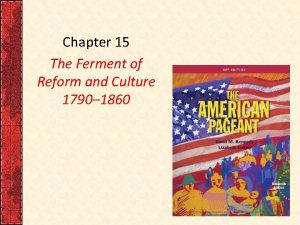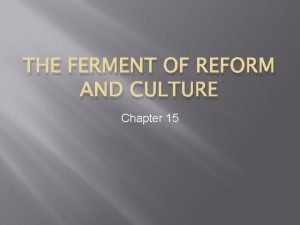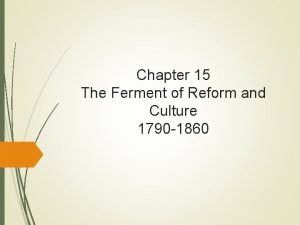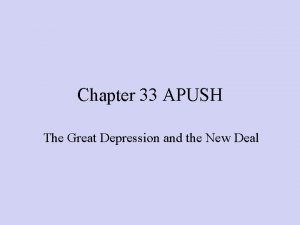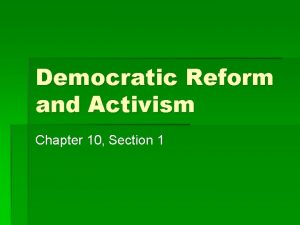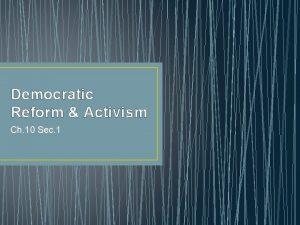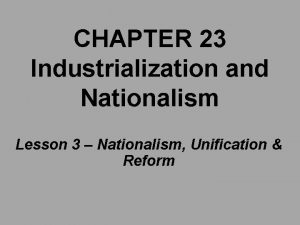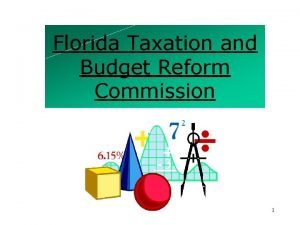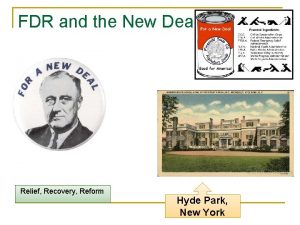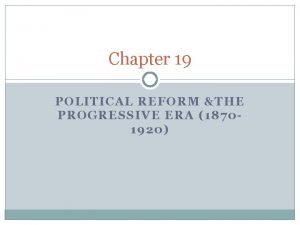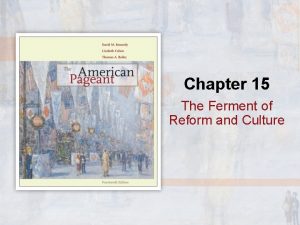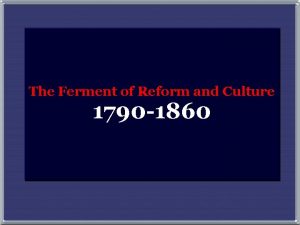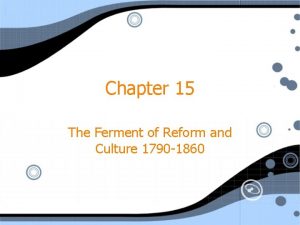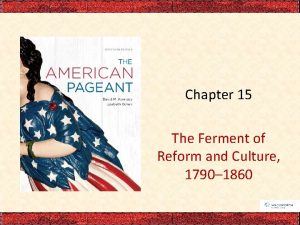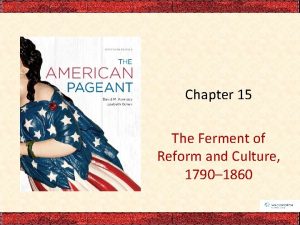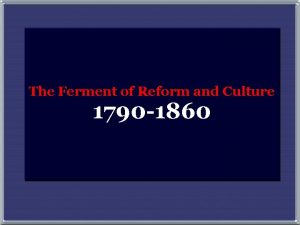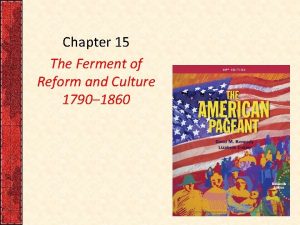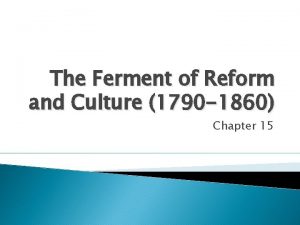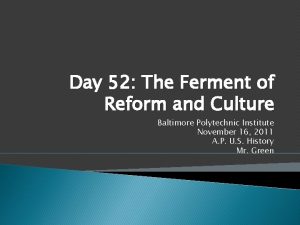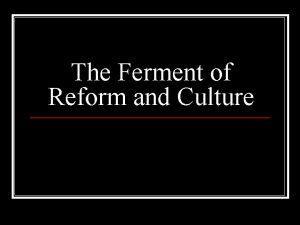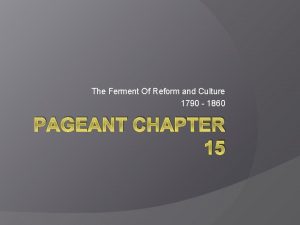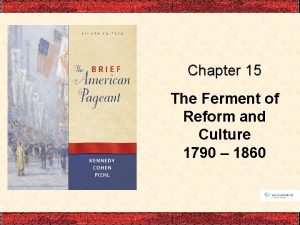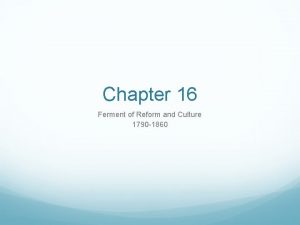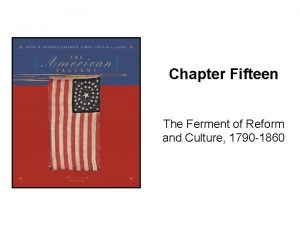The Ferment of Reform and Culture APUSH Ms






























- Slides: 30

The Ferment of Reform and Culture APUSH Ms. Weston 11/6/06

A Third Revolution Jacksonian Era: Changes in politics and American economy n Also, new commitment to improve the character of ordinary Americans n Rise of religious revivals and reform movements n Many different causes—esp. rising ABOLITIONISM (will cover next unit) n

Reviving Religion n Most people still attended church, but people much less devout n n n Deism Unitarianism—much more liberal By 1800, intense reaction to religious liberalism

The Second Great Awakening n n Began on southern frontier, all the way into cities of Northeast Even bigger than First Great Awakening Left many people converted, churches divided into new sects Rising evangelicism— influenced other areas n Prison reform, temperance, women’s movement and abolitionism

Second Great Awakening ctnd. n Spread by huge “camp meetings” n n n Boosted church membership, stimulated humanitarian reforms, missionary work Rising power of Methodists and Baptists n n n 25, 000 people, hellfire gospel, frenzied reactions Stressed personal conversion, democratic control of church affairs, rousing emotionalism Peter Cartwright and Charles Grandison Finney key preachers Feminization of religion n n Women led revival As a result, women would also lead reform movements coming out of religion revival

Denominational Diversity Religious faiths more fragmented n Increasingly divided by class n n Wealthier conservative denominations in East Methodists and Baptists created from fervor in poorer, less educated South and West Northern and Southern churches divide over slavery issue

The Rise of Mormonism n n n Launched by Joseph Smith in 1830 s Opposition in Midwest because of cooperative lifestyle, militia training and charges of polygamy. Brigham Young led Mormons to Utah in 1840 s, after Smith murdered. Able to irrigate and farm in Utah— became a prosperous frontier theocracy and cooperative society Conflicts with government, issues with polygamy meant Utah didn’t become state until 1896.

Push for Public Education n n Tax supported primary schools rare in early years of US Grew between 1825 -1850 n n n Wealthy admit need education for social stability Workers with the vote began pressuring for schools Little red-schoolhouse Only open a few months, Ill trained teachers

Reform in Education n Horace Mann—secretary of Mass. Board of Education n Wanted more and better schoolhouses, longer school terms, expanded curriculum Many adopted these changes Still, not enough schools, many people illiterate, blacks denied education altogether.

Early textbooks n n Noah Webster— “Schoolmaster of the Republic”, reading lessons for children, then dictionary Mc. Guffey readers—in 1830 s—promoted reading, but also lessons in morality, patriotism and idealism

Reforms in Higher Learning n n n Religious zeal led to creation of small, denominational, liberal arts colleges in South and West All colleges offered narrow, tradition-bound curriculum—little intellectual creativity Rise of state-supported universities in South n Supported by federal land grants

Women and Education n Women still seen as unfit for higher education n n Still, Oberlin accepted women in 1837, Mt. Holyoke women’s college opened in same year. Rising acceptance of secondary education for women

Other educational opportunities Rise of private and public libraries n Traveling lecturers—lyceum lecture associations n Magazines—current events, fiction, women’s focus n

An Age of Reform n Most reformers intelligent, inspired idealists n n n Usually inspired by Second Great Awakening Dreams of a perfect society: free from cruelty, war, alcohol, discrimination and slavery Women key, especially in suffrage n n Escape from home for middle-class women Wanted return to traditional values, weren’t really dealing with changing, industrial society

Key Reforms and Reformers n n State legislatures began to abolish debtors prisons Criminal codes in states softened—reduced capital offenses and brutal punishments Dorothea Dix—more humane treatment for mentally ill 1828: American Peace Society —led by William Ladd, wanted an end to war and international peace organizations

Temperance n Custom and difficulties of modern life meant many Americans drank a lot. n n Meant accidents at work, dangers to family and home 1826: American Temperance Society formed in Boston n Led to formation of thousands of local groups Wanted drinkers to sign temperance pledge Used pictures, pamphlets, lectures and songs to keep people away from alcohol

Divide in Temperance Movement Some advocated temperance—getting individual to resist lure of alcohol n Some wanted “teetotalism”—government getting rid of alcohol altogether n n Neal S. Dow—”Father of Prohibition” in Maine— dozens of states passed similar laws in 1850 s.

Women in Revolt n n n Women totally subordinate to men—economically and politically More women resisting traditional path—some avoided marriage altogether. Gender differences emphasized n n n Women seen as physically and emotionally weak, but artistic and refined, Seen as moral gender, responsible for keeping society good Home was women’s sphere (cult of domesticity)

Women reformers Some began to see home as a prison n White, well-to-do women became reformers n Demanded rights for women, and joined with other reformers of age—temperance and abolitionism n

Key Women Activists n n n n Lucretia Mott—Quaker, antislavery and women’s activist Elizabeth Cady Stanton—One of first women suffragists Susan B. Anthony—militant lecturer, suffragist Dr. Elizabeth Blackwell—first female graduate of a medical college Margaret Fuller—writer, fought for Italian unification Grimke Sisters—antislavery activists Lucy Stone—kept maiden name after marriage Amelia Bloomer—wore a short skirt with bloomers

Seneca Falls Convention n n 1848 Women’s Rights Convention Stanton read a “Declaration of Sentiments” that said “all men and women created equal” One resolution demanded ballot for women Launched the modern women’s rights movement

Utopianism n n n Across country, over 40 cooperative, communistic communities established 1825: Robert Owen, New Harmony, Indiana 1841: Brook Farm in Massachusetts 1848: Oneida Community in NY—free love, birth control, eugenic selection of parents for superior offspring Shakers—about 6, 000 in 1840 —prohibited sexual relations, so extinct by 1940.

The Start of Scientific Achievement n n Before 1840 s, science lagged in US. People interested in practical science, or European findings. By 1840, some important scientists n n n Professors of biology, botany—show importance of original research John J. Audubon—bird paintings Medicine still very primitive—life expectancy short, self-prescribed fake medications and treatments n Some developments in 1840 s with anesthetics

Artistic Achievements n Architecture—still dependent on Greek and Roman styles n n Painting also lagged—lack of leisure time, money, respect for art n n n Jefferson—ablest American architect, Monticello Some competent painters emerged —Gilbert Stuart Hudson River School emphasized American landscapes Music—influenced by African. American culture—minstrel shows, slave spirituals

The Rise of a National Literature Before 1812—very little American fiction n After War—emergence of literature as a profession n n Knickerbocker Group in NY—Washington Irving, James Fenimore Cooper—gained world fame, and made writing about American themes acceptable

Transcendentalism n n n 1825 -1850: New England Influenced by religious movements, German philosophers and Asian religions Idea that truth “transcends” the senses—cannot be found by observation alone. Need to find inner light and direct contact with God. Belief in individualism, commitment to selfreliance, self-culture and self-discipline

The Transcendentalists n n Ralph Waldo Emerson—Essays on transcendentalism, stressed self-reliance, self-improvement, self-confidence, optimism and freedom. Henry David Thoreau—poet, mystic, nonconformist. Refused to support government that allowed slavery n n Wrote Walden: Life in the Woods Walt Whitman—romantic, emotional and unconventional poetry n Leaves of Grass

Literary Talent Henry Wadsworth Longfellow—popular poet n John Greenleaf Whittier—antislavery poet n Dr. Oliver Wendell Holmes—poet, essayist, novelist n Louisa May Alcott and Emily Dickinson— women writers n

Literary Talent ctnd. Edgar Allen Poe—dark, horror stories n Nathaniel Hawthorne—wrote of original sin and struggle between good and evil n n n The Scarlet Letter Herman Melville—Moby Dick—epic novel, allegory of good and evil.

Historians of the Era George Bancroft— “Father of American History”—six volumes of history of US n Most from New England, anti-slavery— meant a bias in the way history was told. n
 The ferment of reform and culture
The ferment of reform and culture The ferment of reform and culture
The ferment of reform and culture Chapter 15 the ferment of reform and culture
Chapter 15 the ferment of reform and culture The ferment of reform and culture
The ferment of reform and culture Fermentation reaction
Fermentation reaction Phrenology apush
Phrenology apush Arbitration apush
Arbitration apush Ethnocentrism examples
Ethnocentrism examples Continuous culture and batch culture
Continuous culture and batch culture American culture vs indian culture
American culture vs indian culture Stab culture and stroke culture
Stab culture and stroke culture Folk culture and popular culture venn diagram
Folk culture and popular culture venn diagram Leisure
Leisure Urease test
Urease test Homework due today
Homework due today Pour plate method
Pour plate method Carpet culture method
Carpet culture method Surface culture deep culture and esol
Surface culture deep culture and esol Sociologists define a symbol as
Sociologists define a symbol as Batch culture vs continuous culture
Batch culture vs continuous culture Characteristics of collectivism
Characteristics of collectivism Counterculture vs subculture
Counterculture vs subculture Inert organizational culture
Inert organizational culture Quality culture changing hearts minds and attitudes
Quality culture changing hearts minds and attitudes Democratic reform and activism
Democratic reform and activism Chapter 10 section 1 democratic reform and activism
Chapter 10 section 1 democratic reform and activism Chapter 23 lesson 3 nationalism unification and reform
Chapter 23 lesson 3 nationalism unification and reform Revolution brings reform and terror
Revolution brings reform and terror Taxation and budget reform commission
Taxation and budget reform commission Examples of relief recovery and reform
Examples of relief recovery and reform Chapter 19 political reform and the progressive era
Chapter 19 political reform and the progressive era
